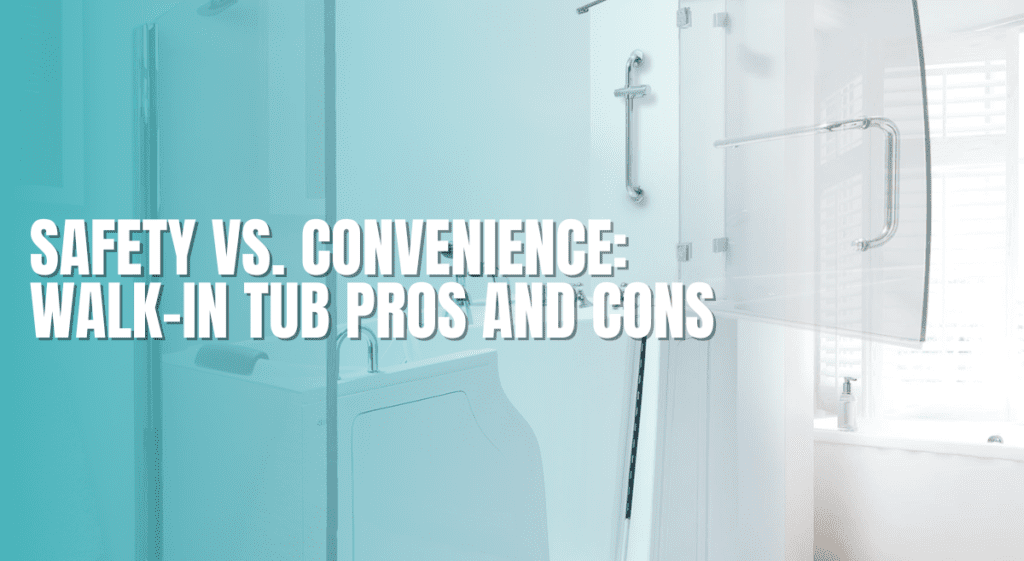Safety vs. Convenience: Walk-In Tub Pros and Cons
Imagine transforming your daily bath routine into a safer and more convenient experience.
Did you know that walk-in tubs offer a perfect balance between safety features and modern conveniences? Discover how these innovations can revolutionize your bathroom experience.
The best part? Achieving the perfect blend of safety and convenience doesn’t have to be complicated. Stay with us, and we’ll guide you through the walk-in tub pros and cons.
What Are Walk-In Tubs?
Walk-in tubs are bathtubs with a door that swings open and shut, making it easy to enter and exit the tub without having to step over a high threshold. This makes them a safer and more convenient option for people with mobility issues.
Walk-in tubs are often recommended for seniors and people with mobility issues, as they can help to reduce the risk of falls and slips in the bathroom. However, anyone can benefit from a walk-in tub, as they offer a number of safety and convenience features. Exploring the walk-in tub pros and cons can assist in making an informed decision tailored to in
Why Consider a Walk-In Tub?
There are many reasons to consider a walk-in tub, including:
- Safety: Walk-in tubs are designed with safety features to reduce the risk of accidents. The low threshold makes it easier to enter and exit the tub, and the built-in seat provides a safe place to sit while bathing. Additionally, many walk-in tubs come with features such as grab bars, non-slip surfaces, and safety alarms.
- Convenience: Walk-in tubs are also more convenient than traditional bathtubs. The ease of entry and exit makes them ideal for people who have difficulty getting in and out of a regular tub. Additionally, many walk-in tubs come with features such as hydrotherapy jets, heated seats, and aromatherapy, which can provide a more relaxing and enjoyable bathing experience.
- Accessibility: Walk-in tubs are more accessible than traditional bathtubs for people with disabilities. Many walk-in tubs are wheelchair accessible, and some models even have features such as built-in lifts and grab bars.
- Hydrotherapy: Many walk-in tubs come with hydrotherapy features, such as jets and air bubbles. Hydrotherapy can provide a variety of health benefits, such as pain relief, muscle relaxation, and improved circulation.
Safety Benefits of Walk-In Tubs
Walk-in tubs offer a number of safety benefits, including:
- Reduced risk of falls and slips: Falls and slips are a leading cause of injuries and deaths among seniors. The low threshold and built-in seat of a walk-in tub can help to reduce the risk of falls and slips by making it easier to enter and exit the tub.
- Easier entry and exit: Walk-in tubs are easier to enter and exit than traditional bathtubs. The low threshold eliminates the need to step over a high tub wall, and the built-in seat provides a safe place to sit while getting into and out of the tub.
- Built-in seat and grab bars: Many walk-in tubs come with a built-in seat and grab bars. The seat provides a safe place to sit while bathing, and the grab bars provide additional support and stability.
- Hydrotherapy features for pain relief and relaxation: Hydrotherapy features, such as jets and air bubbles, can provide pain relief and relaxation. This can be especially beneficial for people with arthritis, muscle pain, and other medical conditions.
Convenience Benefits of Walk-In Tubs
Walk-in tubs also offer a number of convenience benefits, including:
- Easy to use and clean: Walk-in tubs are easy to use and clean. The door makes it easy to enter and exit the tub, and the smooth surfaces make it easy to clean.
- Variety of features and options available: Walk-in tubs are available in a variety of features and options, so you can choose a tub that meets your specific needs. For example, some walk-in tubs come with hydrotherapy jets, heated seats, and aromatherapy.
- Can be installed in most homes: Walk-in tubs can be installed in most homes. However, it is important to have the tub installed by a qualified professional.
Cost and Maintenance Considerations
Walk-in tubs can be expensive, but there are financing options available. Additionally, the cost of a walk-in tub may be offset by the savings on medical bills and other expenses associated with falls and injuries.
Walk-in tubs require regular maintenance to keep them clean and in good working order. However, the maintenance requirements are generally simple and easy to follow.
Is a Walk-In Tub Right for You?
Whether or not a walk-in tub is right for you depends on your individual needs and circumstances. If you are a senior, have mobility issues, or are concerned about the risk of falls and slips in the bathroom, then a walk-in tub may be a good option for you.
Now that you’re armed with the knowledge of walk-in tub pros and cons, take the next step towards a safer and more convenient bathing experience. If you found this information helpful, check out our guide on optimizing your entire home for accessibility or share your thoughts in the comments below. Your journey to a safer, more convenient bathroom starts here!

